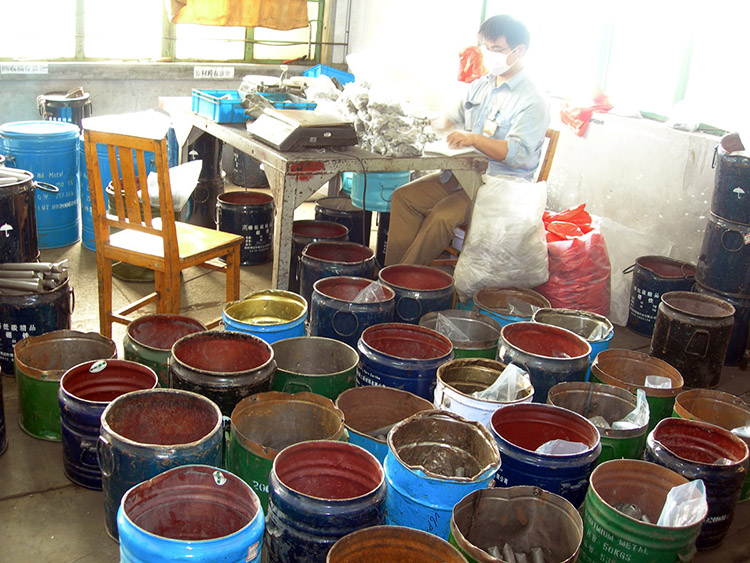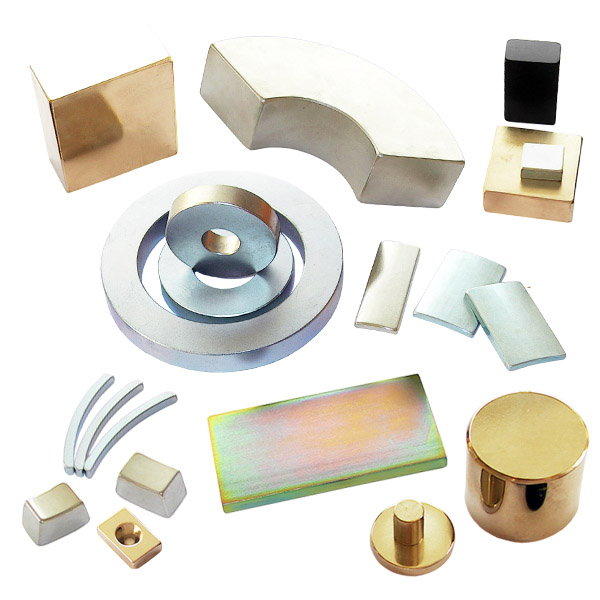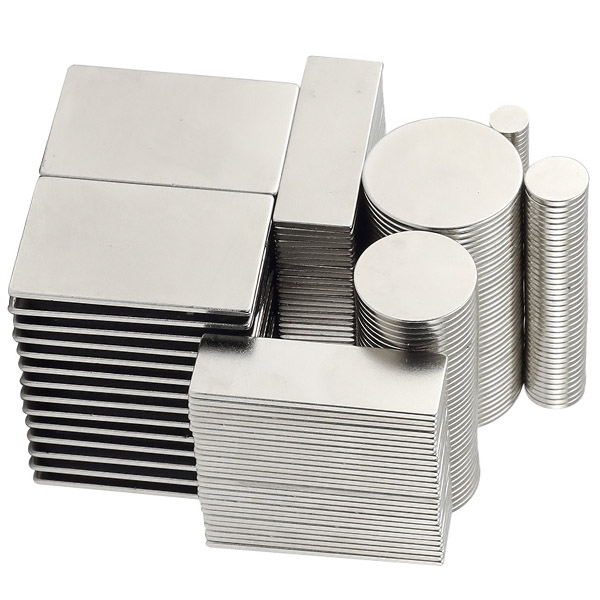The preparation process of sintered NdFeB magnet-(1) raw material preparation

Sintered magnets usually use pure metals or master alloys as raw materials, and use the electromagnetic induction heating principle of alternating magnetic fields to generate eddy currents in the raw materials. The raw materials are melted by induction melting in a vacuum or inert gas environment, so that the raw materials are heated and melted. The melt is stirred to homogenize. The melting point of rare earth metals is between 800°C and 1500°C, Fe and Co are 1536°C and 1495°C respectively, and pure B is as high as 2077°C. Some high melting point metals used as additives, such as Ti, Cr, Mo or Nb, have melting points at 1600~3400℃. Considering the suppression of the volatilization of rare earth elements, the melting temperature is usually controlled at 1000~1600℃. The high melting point elements are melted by the alloying effect of the rare earth metal melt, or alloys of high melting point elements (usually iron alloys) are directly used as raw materials, such as B-Fe (melting point ~1500°C), Nb-Fe (melting point ~1600°C) alloy, etc. In order to ensure a low-oxygen environment for melting and casting, it is necessary to vacuum the melting and casting furnace body, and fully vent all parts and raw materials in the furnace. The vacuum level usually reaches 10-2~10-3, and the furnace body is heating. The previous pressure increase rate (internal venting and external leakage) also needs to be controlled at a lower level. For example, for a melting furnace with a capacity of 1t, the pressure increase rate should be lower than 5×10-4~1×10-3 L/s . Vacuum smelting can fully degas the molten liquid, remove low-boiling impurities and harmful gas elements, and improve the purity of the alloy. However, due to the low vapor pressure of rare earth metals (less than 1Pa), the volatilization loss is very considerable, so it is usually correct during the smelting process. The furnace body is filled with inert gas, and the ambient pressure is increased to suppress the volatilization of rare earths. It is more convenient to use high-purity argon gas, which is generally charged to the level of 50kPa. After the homogenization of the alloy melt, exhaust gas and slagging are fully completed, the casting can be carried out. Alloy casting is a very critical process, because the phase composition, crystalline state and spatial distribution are critical to the performance of the sintered magnet. The alloy ingot has undergone heavy "cannonballs", 20mm thick "books", and 5mm "pancakes". "At present, it has developed to a quick-setting sheet with a thickness of only 0.3mm. The industry has made many efforts to avoid component segregation and impurity phase generation, and to rationally distribute the neodymium-rich phase distribution.
1. Smelting
Rare earth raw materials are usually in the form of pure metals. Rare earth alloys are often selected for cost reasons, such as praseodymium neodymium metal, lanthanum cerium metal, mixed rare earth and dysprosium iron alloy, etc.; high melting point element components (such as: B, Mo, Nb, etc.) It is mostly added in the form of ferroalloy. Nd-Fe-B magnets have the characteristics of a multi-metal phase. The Nd-rich phase is a necessary condition for high coercivity, and the B-rich phase must also co-exist. Therefore, it is usually required that the rare earth and B in the original formulation are higher than the positive components of R2Fe14B, but Sometimes in order to adjust the composition of the grain boundary phase (especially when Cu, Al, and Ga are added), the B content may be slightly lower than the normal component. Due to the reaction of rare earth metals and crucible materials, as well as smelting and sintering volatilization, a certain amount of loss of rare earth metals needs to be considered when formulating. In order to reduce the impurity content in the alloy, the purity of the raw materials must be strictly controlled, and the oxide layer and attachments on the surface must be fully removed. The heat source of medium and low frequency induction smelting is the induced eddy current formed by the alternating magnetic field in the raw material. The skin effect of the eddy current causes the current to concentrate on the surface of the raw material. If the size of the raw material block is too large, the eddy current cannot penetrate to the center of the material block. The ability to melt the core by heat conduction is very unrealistic in actual production, so the size of the raw material should be adjusted according to the choice of frequency, and it should be controlled at 3 to 6 times the skin depth. The figure below shows the relationship between power frequency-skin depth-raw material size. It can be seen that the higher the frequency, the more significant the skin effect and the smaller the raw material size.
The choice of smelting frequency is subject to another important function of induction smelting—electromagnetic stirring, which uses the force interaction between the molten metal and the alternating magnetic field to promote the melting of unmelted solids and the homogenization of the molten metal. The size is inversely proportional to the square root of the current frequency. Too high frequency will weaken the electromagnetic stirring effect of the alternating power supply. The frequency band used in actual production is around 1000~2500Hz, and the raw material size needs to be controlled below 100mm.
The stacking of raw materials in the crucible must take into account the induced magnetic field and the spatial distribution of the temperature during the smelting process. Usually the induction coil is wound on the outer side of the crucible. The inner side of the crucible has the strongest magnetic field and gradually weakens toward the center, but the side, bottom and upper side of the crucible The opening is the main way for heat to escape, so the temperature of the bottom side of the crucible is in the middle, the temperature in the middle of the upper and bottom surfaces is low, and the temperature in the middle is the highest. Therefore, it is advisable to place small pieces of low melting point materials densely at the bottom of the pot when charging; place high melting point materials and bulk materials in the middle and lower parts; place large pieces of low melting point materials on the upper part and be looser to prevent bridging. Nowadays, continuous smelting-casting technology has been widely adopted. The raw materials are gradually added to the crucible at high temperature through the feeding chamber. To control the volatilization of rare earth materials, pure iron is usually added to melt first, then the high melting point metals or alloys are added sequentially, and the rare earths are added finally.
2. Casting
Rare earth binary or ternary alloys inevitably form α-Co or α-Fe phases under slow (close to equilibrium) cooling conditions. Their room temperature soft magnetic properties will seriously damage the permanent magnetic properties of the magnets, and they must be passed quickly Cool to suppress its formation.
In order to achieve the required quenching effect, the traditional ingot mold casting technology has been working hard in the direction of reducing the thickness of the alloy ingot. The advantages of ingot mould casting are low equipment cost and simple operation, which can meet the general production requirements of magnets. The disadvantage is that the crystal grain size is uneven and α-Co or α-Fe phases are often precipitated. Long-term heat treatment of the alloy ingot at a temperature lower than the melting point of the alloy will help eliminate the α-Co or α-Fe phase, but will cause the accumulation of the Nd-rich phase, which is not conducive to the optimal distribution of the grain boundary phase of the sintered magnet.
In order to further reduce the thickness of alloy ingots, a pancake-like "disc-scraper" structure was developed to make the thickness of the alloy reach about 1cm. However, the increase of the alloy area has brought a lot of trouble to the material collection of the large-capacity smelting furnace. . Another effective technology development path is the opposite. Starting from the extremely high cooling rate for preparing fast-quenched Nd-Fe-B alloys, try to reduce the cooling rate to prepare fast-cooling crystalline alloys, which are called strips. The technology of casting or strip casting (strip casting or SC) came into being. It is to pour molten alloy onto a rapidly rotating water-cooled metal wheel through a guide trough to obtain an ideal thickness of 0.2~0.6mm, phase composition and texture Alloy flakes. In the alloy structure of strip casting, the uniform distribution of the Nd-rich phase and the suppression of α-Fe reduce the total rare earth content, which is beneficial to obtain high-performance magnets and reduce the cost of the magnet; the disadvantage is that the volume fraction of the Nd-rich phase is reduced Compared with the magnet produced by ingot mould casting, the brittleness of the magnet is increased, and the difficulty of post-processing is increased.


